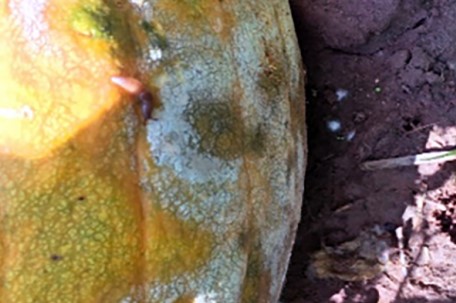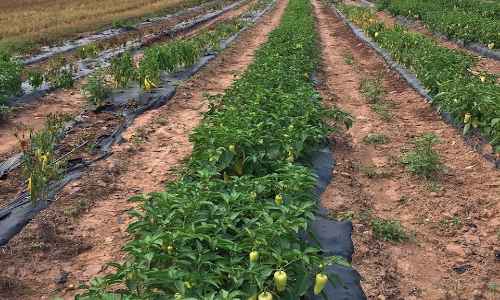By John Esslinger
Phytophthora blight (Phytophthora capsici) is a serious problem and the number of Pennsylvania vegetable farms infected continues to increase. Finding clean fields to grow susceptible crops has become more challenging.

Pumpkin infected with Phytophthora capsici.
An on-farm research trial was established in 2020 to measure the benefit of using fungicides applied to foliage early in the season to manage Phytophthora Blight (Phytophthora capsici) in pumpkins. The intent of the trial was to determine if the foliar application of fungicides would be effective at managing Phytophthora blight which is caused by a soil-borne pathogen. The after-planting foliar application approach could be used by growers who do not grow drip-irrigated pumpkins.
The pumpkins were seeded on May 29, 2020, and transplanted into a field with a known history of Phytophthora blight on June 12. The field was plowed and worked on June 10. Five treatments were randomly replicated three times. Each plot contained 5 plants at 3 ft. in-row spacing. Fungicide applications were made on June 26, July 13, and July 29. Insecticide was applied to control cucumber beetle. A deer fence was erected on June 26.
The treatments included three applications at labeled rates of Revus (8.0 fl oz/A, Syngenta Crop Protection) tank-mixed with Copper (1 lb./A, Nu Cop HB, Agri Star), Revus tank-mixed with Tanos (8.0 oz, Corteva Agriscience), Revus tank-mixed with Orondis Opti (2 pt./A, Syngenta Crop Protection), Orondis Opti alone, and a check that received only chlorothalonil. Please note that the Orondis Opti label does not allow more than 2 consecutive applications without rotating to different chemistry. The fungicides were applied with a backpack sprayer, and careful attention was given to ensure thorough coverage.
This farm experienced rain events of over an inch in June and early July 2020. August and September received less than normal rainfall. Plots were rated three times during the season based on Phytophthora blight incidence and severity using a scale of 1 = significant loss to 5 = no symptoms of Phytophthora blight.
Results
Combined average scores by treatment from evaluations made on August 10, August 24, and September 9. The ratings are a comparative level of disease severity. The first infected fruit was observed during the August 10 evaluation.
1 = significant loss and 5 = no loss to phytophthora blight
- Revus and Copper = 4.9
- Revus and Tanos = 4.6
- Revus and Orondis Opti* = 3.7
- Orondis Opti* = 3.2
- Check - Chlorothalonil = 2.9
*The Orondis Opti label allows for no more than two consecutive applications before rotating to different chemistry.
Conclusions
Unsurprisingly, the rainfall pattern had a significant impact on the outcome of the trial. The fact that the soil was wet early in the growing season allowed Phytophthora blight to get an early foothold. The treatments including Revus performed well. There was not a noticeable difference between the Revus tank-mixed with Nu Cop HB and the Revus tank-mixed with Tanos. The Revus combined with Orondis Opti did not perform as well as expected.
The Orondis Opti applied as a foliar application did not appear to provide early season control when rainfall was plentiful and only one application had been applied. It appeared to be more effective after all three applications were made. Considering the rainfall patterns on this farm in 2020 where Phytophthora blight disease pressure was high early in the summer, an application of Orondis Gold applied at or shortly after planting may have been more effective.
While no treatment provided complete control of Phytophthora blight, all the treatments gave better control than the check.
Successful management of Phytophthora blight requires an integrated approach. Continue to manage Phytophthora blight with crop rotation to non-susceptible crops such as a grass, measured irrigation, soil management (avoiding compaction and good organic matter content), and using resistant cultivars when available. The picture below is of a pepper field in Luzerne County. Note the center row is a phytophthora resistant cultivar while the rows to the left are a susceptible cultivar.

The Pennsylvania Vegetable Growers’ Association and the Pennsylvania Vegetable Marketing and Research Program provided the funding to purchase the fungicides used in the research.
Source : psu.edu